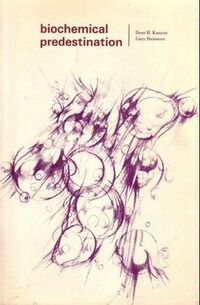Biology:Biochemical Predestination
 | |
| Author | Dean H. Kenyon and Gary Steinman |
|---|---|
| Country | United States |
| Language | English |
| Subject | Biochemical origin |
| Genre | Probability theory |
| Publisher | McGraw Hill Text |
Publication date | January 1969 |
Biochemical Predestination is a 1969 book by Dean H. Kenyon and Gary Steinman which argued in support of biochemical evolution.[1]
In the book, Kenyon and Steinman conclude that "Life might have been biochemically predestined by the properties of attraction that exist between its chemical parts, especially between amino acids in proteins."[2] They argued that life originated with the chemical properties of amino acids causing them to be attracted to each other, forming long protein chains, most important in every living cell. Kenyon believed that proteins were directly formed by attraction between amino acids without DNA coding, and that these were derivatives from non-living raw chemicals in a conducive environment.
In 1976 Kenyon was persuaded by the young Earth creationist arguments of A. E. Wilder-Smith.[3] In the 1982 foreword he wrote to What Is Creation Science? by Henry M. Morris and Gary Parker, Kenyon said that he no longer accepted the pro-evolution arguments in Biochemical Predestination. At the Edwards v. Aguillard trial he provided an affidavit in support of creation science and noted the book as one of his publications. Kenyon subsequently became a co-author of Of Pandas and People which rebranded creation science as intelligent design.[1][4]
Analysis
The theory propounded was summarized by Stephen Berry, a chemist; "describing the following causal chain: the properties of the chemical elements dictate the types of monomers that can be formed in prebiotic syntheses, which then dictate the properties of the occurring polymers, which finally dictate the properties of the first eobionts and all succeeding cells."[5] Kenyon's work was about virus production.[6] Intelligent design proponent Stephen C. Meyer says that the book provided a new approach which came to be known as "Self-organization".[7]
Kenyon began to doubt his theory in the mid-1970s after a student posed the question to him as to how the first proteins could have been assembled without specific genetic instructions.[9] On a fellowship at the Graduate Theological Union in Berkeley during the 1969–1970 academic year, he reviewed literature on the relationship of science and religion. He began to rethink his Christian faith, and explored the topic further in a 1974 sabbatical at the University of Oxford. In 1976, a student gave him a book by the young Earth creationist A. E. Wilder-Smith, and "Eventually, several other books and articles by neo-creationists came to my attention. I read some of Henry Morris’ books, in particular, The Genesis Flood. I'm not a geologist, and I don't agree with everything in that book, but what stood out was that here was a scientific statement giving a very different view of earth history. Though the book doesn't deal with the subject of the origin of life per se, it had the effect of suggesting that it is possible to have a rational alternative explanation of the past."[3] In 1976 he wrote a new section for Morris and Whitcomb's The Genesis Flood: The Biblical Record and Its Scientific Implications. In the 1982 foreword he wrote to What Is Creation Science? by Morris and Gary Parker, Kenyon said that he no longer accepted the pro-evolution arguments in Biochemical Predestination. At the Edwards v. Aguillard trial he provided an affidavit in support of creation science and noted the book as one of his publications. Kenyon subsequently became a co-author of Of Pandas and People which rebranded creation science as intelligent design.[1][4]
References
- ↑ Jump up to: 1.0 1.1 1.2 Kenyon, Dean H. (17 September 1984). "Edwards v. Aguillard: Dean Kenyon's Affidavit". TalkOrigins Archive. http://www.talkorigins.org/faqs/edwards-v-aguillard/kenyon.html. Retrieved 1 July 2013.
- ↑ Unlocking the Mystery of Life, Illustra Media, a branch of the Discovery Institute, and Focus on the Family, 2002
- ↑ Jump up to: 3.0 3.1 "Dean Kenyon: a young-earth creation scientist who was later relabeled an intelligent design proponent - The Panda's Thumb". 20 July 2010. http://pandasthumb.org/archives/2010/07/dean-kenyon-a-y.html. Retrieved 1 July 2013.
- ↑ Jump up to: 4.0 4.1 Forrest, Barbara (1 April 2005). "Expert Witness Report". National Center for Science Education. pp. 15–16. http://ncse.com/files/pub/legal/kitzmiller/expert_reports/2005_04_01_Forrest_expert_report_P.pdf. Retrieved 1 July 2013.
- ↑ "Biochemical Predestination" as Heuristic Principle for Understanding the Origin of Life" by Stephen Berry, J. Chem. Educ., 1997, 74 (8), p 950 doi:10.1021/ed074p950 Link
- ↑ "Prof Flips Theory Coin About Virus Production," Winnipeg Free Press, Wednesday, March 22, 1972. p. 43
- ↑ Meyer, Stephen C. (23 June 2009). Signature in the Cell: DNA and the Evidence for Intelligent Design. HarperCollins. pp. 229–. ISBN 978-0-06-147278-7. https://books.google.com/books?id=laW5vuTLNXEC&pg=PA229.
- ↑ Pinno, A. Arthur (January 2011). God Is!. Xulon Press. pp. 71–. ISBN 978-1-61215-621-7. https://books.google.com/books?id=auSnPz0PXcAC&pg=PA71.
- ↑ Colson, Charles (14 July 2011). How Now Shall We Live?. Tyndale House Publishers, Inc.. p. 74. ISBN 978-1-4143-2242-1. https://books.google.com/books?id=Cmlf9UnQa0EC&pg=PA74. Retrieved 30 May 2013.
 |

